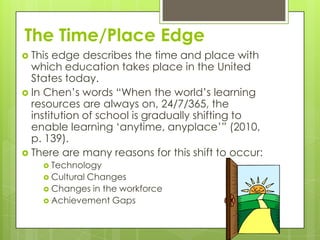The time and place edge
•Télécharger en tant que PPTX, PDF•
0 j'aime•188 vues
A synopsis of Milton Chen's Education Nation: Six Leading Edges of Innovation.
Signaler
Partager
Signaler
Partager

Recommandé
Recommandé
Contenu connexe
Similaire à The time and place edge
Similaire à The time and place edge (20)
Education Nation: Six Leading Edges of Innovation in our Schools

Education Nation: Six Leading Edges of Innovation in our Schools
Creating Effective Learning Environments For Learners

Creating Effective Learning Environments For Learners
Learning Spaces- what are they and why they are important

Learning Spaces- what are they and why they are important
Chapter 1 of "Open Learning Cultures. A Guide to Quality, Evaluation and Asse...

Chapter 1 of "Open Learning Cultures. A Guide to Quality, Evaluation and Asse...
The time and place edge
- 1. The Time/Place Edge This edge describes the time and place with which education takes place in the United States today. In Chen‟s words “When the world‟s learning resources are always on, 24/7/365, the institution of school is gradually shifting to enable learning „anytime, anyplace‟” (2010, p. 139). There are many reasons for this shift to occur: Technology Cultural Changes Changes in the workforce Achievement Gaps
- 2. The Time Factor In the United States, unlike other countries in the world, the ability for learning to occur is regulated by the clock and the class change bell. The school schedule not only limits learning, but also increases the separation between subject areas. Increasing the time spent in class will have little impact unless there is a fundamental change in what teachers do within that time. This is best described with a quote from the book, “A lousy eight hour day is worse than a lousy six hour day” (2010, p. 145).
- 3. Place Based Learning Inplace based learning, students explore topics outside of the classroom. This type of learning is an extension of problem based learning. This allows for students to see the application of school concepts in real life. These learning communities rely on support from the community and outside government agencies. Place based learning can take place in zoos, national parks, local ecosystems, museums, factories, and even farmer‟s markets.